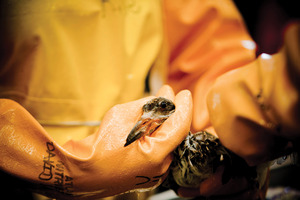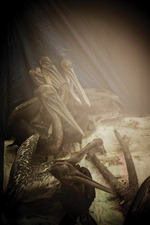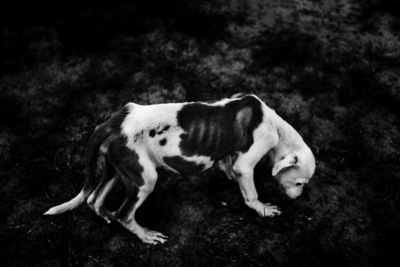Dry Docked: The New Life of Venice and Grand Isle, Louisiana
 A local man involved in cleanup.Photography and Text by Zoriah Miller
A local man involved in cleanup.Photography and Text by Zoriah Miller
As a photojournalist, I learn something new from each and every project I do. Sometimes I come away from a story with profound new facts, information that I never could have discovered had I not just gone and experienced it myself. Sometimes what I learn is life changing, knowledge that opens my eyes and allows me to see the world and humanity in a completely new light.
Other times I feel like I learn very little, and in some cases I feel like I know less about a situation than I thought I did going into it. This was my experience shooting the aftermath of one of the worst oil spills in history, the BP Gulf Oil Spill.
Going into the project, I pictured angry fishermen protesting on the streets, fighting for a livelihood that had been passed down from generation to generation. I pictured oil-drenched beaches with dead animals strewn about and thick sludge as far as the eye could see. I pictured eye-opening conversations with scientists and wildlife officials. But what I actually found when I arrived was, for the most part, quite different.
I knew from the research I did that Louisiana would be the best place to document from. What I did not know was that the two areas primarily affected by the spill, Venice and Grand Isle, were quite far apart from each other. While you could actually make it from one place to the other by boat in about 30 minutes, the drive between the two was close to 10 hours round trip.
I ended up finding a place to stay in New Orleans and commuted into the areas each day, which cut my driving time down to about five hours round trip.
The beginning of the two-week project was spent in Venice. I thought I would check out the coastline, speak to some fishermen and gather some direction from those experiences. However, when I arrived the fishermen all seemed to be quite content, for the most part. BP had made a very smart decision and offered work, at a relatively high rate of pay, to all of the fishermen. Shrimping boats were being used to place oil booms, cutters were used as skimming boats and charter boats were involved in all sorts of different operations from surveying the damaged areas to cleanup and animal rescue. An oiled bird is washed and treated in a rehabilitation center.
An oiled bird is washed and treated in a rehabilitation center.
In order to get the images I needed to tell this story, I would meet up with staff at the Coast Guard or the Department of Fish and Wildlife, hop on one of their boats and begin the two hour trip out to the oil affected waters and marshlands.
Most days it felt as though we were chasing the oil. I wanted pictures of it, the scientists on the boats wanted samples of it and the wildlife folks wanted to document its effects on animals and of course rescue and rehabilitate if possible. Sometimes we went out on planes to fly over the spill site, other times blimps and helicopters would relay information and GPS coordinates to us while we were out on the boats.
The interesting thing about this situation was that no one, no matter how smart they were or how specialized their skills were, had any idea what to expect on a day to day basis or long term. We never knew if we would see oil or affected wildlife or not. No one seemed to know where the oil was heading. People had theories about the oil sinking or remaining under the surface. Others thought it had just gotten pushed towards other areas. Some thought the dispersants had done something odd to the oil.
Basically this was a first of its kind event. Oil, in an unknown state (chemically) had come from very deep under the sea and had been dumped into the water without any treatment or processing. Then it was mixed with chemicals, the effects of which are not really understood in either refined oil or raw form. Add shifting tides to the equation, storms, salt water, duration in water—add it all together and you have a gigantic mystery, one in which around 80 million gallons of oil just go missing.
The effects on wildlife after the spill are also difficult to understand. The research on animal survival rates after oil spills has a lot of variables. Factoring in the new variables involved in this particular spill, no one really has any idea what will happen.
Fishermen don’t know how long the money from BP will keep flowing in, and once it is gone they have no idea if they will be able to return to their old way of life, which for many is the only way of life they know. The charter fishing business is gone, or at least on hold indefinitely, so the tourism economy in these communities has also been destroyed. More than 80 percent of those living in these areas make their living from the fishing industry, either directly or indirectly. A fish and wildlife worker puts a toe tag on a bird found dead in the wake of the oil spill.
A fish and wildlife worker puts a toe tag on a bird found dead in the wake of the oil spill.
The uncertainty about income, completely new hours and schedules and fear of what may happen in the future has led many local families to give up their pets to shelters in fear of not being able to properly care for them. A dog recovers from near starvation in a local animal shelter in St. Bernard Parish, LA. Animal shelters have been overflowing with animals since the oil spill, as locals are unable to afford their pets.
A dog recovers from near starvation in a local animal shelter in St. Bernard Parish, LA. Animal shelters have been overflowing with animals since the oil spill, as locals are unable to afford their pets.
Like most of the people involved in this spill, I came away from it not really knowing what I learned from it. Yes, I did see horrible things. I saw massive amounts of oil in a host of strange forms. I saw oiled birds and fish, dead or struggling; I saw dying marshlands, beaches with oily shores and oil in the water as dolphins swam through seemingly unaware. I saw animal shelters overflowing with dogs and cats whose owners could not afford to keep them, bird rehabilitation shelters with workers diligently cleaning animals and fishermen with unknown fates. Oil washes ashore onto Louisiana marshlands
Oil washes ashore onto Louisiana marshlands
There are a huge range of effects from this spill that can be seen right now, but to me, and most others involved in its cleanup, the scariest aspect is the future and all of the unknowns. A dolphin swims through waters in one of the more highly effected oil spill regions. The waters are home to countless varieties of fish and wildlife.
A dolphin swims through waters in one of the more highly effected oil spill regions. The waters are home to countless varieties of fish and wildlife.
